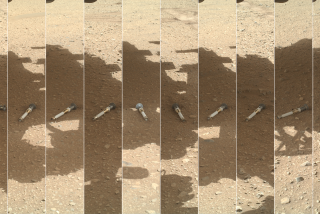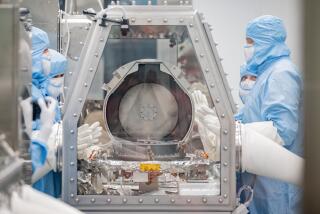NASA officials talk challenges, and thrills, of capturing an asteroid
- Share via
Having trouble getting excited about NASA’s planned mission to redirect an asteroid? Maybe William Gerstenmaier can help.
“Turn off your logical side and turn on your touchy-feely side, the one you almost never use,” Gerstenmaier, associate administrator for NASA’s Human Exploration and Operations Directorate, told attendees of an aeronautics and astronautics conference Wednesday in San Diego. “Then jump up and down and do some break-dancing. We’re going to grab a space rock and we’re going to move it!”
Gerstenmaier’s comments came at the end of an hourlong panel discussion that included five NASA officials charged with coordinating the agency’s plan to capture an asteroid, drag it into lunar orbit and then send a pair of astronauts to meet up with it and collect a sample.
The mission, as planned, will unfold over four or five years, said Brian Muirhead, chief engineer at NASA’s Jet Propulsion Laboratory in La Cañada Flintridge. It will probably take a year and a half to get a spacecraft to the asteroid, and after its spin has been slowed and it has been bagged, three more years to redirect the space rock into a stable orbit around the moon.
Once the asteroid is in lunar orbit, NASA officials said it would take astronauts nine days to get to it, where they would perform two four-hour spacewalks to sample it. Then it’s an 11-day trip to get home.
“This is a bold mission,” said Steve Stich, deputy director of engineering at NASA’s Johnson Space Center. “We are talking about sending two crew further than we’ve ever been in space.”
The agency’s still-developing plan will include a lot of firsts for manned spaceflight, including the first lunar gravity assist during a manned mission, and the first time that a crew will not have the luxury of coming home in a matter of hours or days if something goes wrong, Stich said.
“The worst-case scenario we’ve looked at would take the crew 27 days to come back,” he said. “But when I look at Mars, those transit times are nine months, and the way we look at it, this mission is kind of a steppingstone to Mars.”
The NASA officials emphasized that the asteroid redirect mission is still in the planning phases. Muirhead said the agency hadn’t decided whether it would go after a small asteroid about 20 to 30 feet in diameter (like the one in the video above) or instead try to rip a boulder off a larger asteroid and bring the piece back to Earth.
When asked what NASA would do after the mission was over and the asteroid was still orbiting the moon, the panel members said they weren’t sure.
“We could go back to it with a government-led mission, or even down the way open it up to commercial companies,” said Stich. “We’re still talking about what we want to do.”
The panelists said they hoped to have made some of the major decisions by the end of the year.
“The important thing is we laid out the concept, but we are still open to other ideas and suggestions,” said Gerstenmaier.
Return to the Science Now blog.







